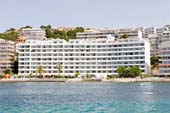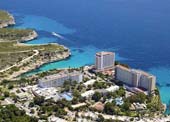A large, rather touristy resort built around a number of small coves and bays, Cala D’Or is situated on the east coast of Majorca, and developed as a holiday destination somewhat earlier than many of its counterparts. This former fishing village, is now barely recognisable as such, and styles itself as a rather upmarket resort, based around its chic marina. A quick look at the boats in the harbour at Cala D’Or, will tell you that this is a resort favoured by the well-heeled, though don’t let this put you off, if you are planning a visit, as there is plenty of affordable accommodation to be had in Cala D’or, with a choice of hotels and plenty of self-catering villas and apartments to rent. When the weather is good, the place to head is the beach, though in July and August, get there early to get a decent spot, when the weather is not so good, try visiting one of the local street markets, such as at Porto Colom or Felanitx.
February 19, 2011
Cala Bona Majorca
Another Majorca fishing village, turned holiday resort, Cala Bona is a good spot for water sports enthusiasts, and its appeal to holidaymakers was increased by the addition of three man-made beaches. Somewhat quieter than its better known neighbour Cala Millor, Cala Bona (which means “Good Bay”), provides an ideal location for a laid back family holiday. When the weather is sunny, the place to be is the beach, and with 3 to choose from, you should be able to find a decent spot. While you are staying in Cala Bona, take some time out for a trip on the glass-bottomed boat, and get an interesting insight into the varied sea life to be found off this part of the Majorca coast.
February 17, 2011
Cala Egos Majorca
Beginning a short series of articles on Majorca resorts, I am starting with a little known but still fairly popular coastal resort on the east coast of the island. Cala Egos (I haven’t been able to find a meaning of the name!), is close to the better known Cala D’Or, and its residential areas are very close to the marina of Cala D’Or. Cala Egos is a mostly residential area with numerous large villas, and also a number of apartment complexes, it has some bars and restaurants, and has easy access to a number of small beaches and pretty little coves, for which this area is well known. A stay in Cala Egos would suit those looking for a quiet family holiday away from the hustle and bustle of Magaluf and similar resorts. Majorca Map.
September 23, 2010
Santa Ponsa Verdemar Apartments
A good choice for your accommodation in the popular resort of Santa Ponsa on the holiday island of Mallorca in the Spanish Balearic Islands, is the Verdemar Apartments complex, located in Calle Ramon de Moncada close to local amenities and beaches. Apartments in the Verdemar Santa Ponsa offer rooms with bathroom, balcony, kitchenette, safe, etc, complex facilities include 24 hour reception, restaurant, bar, laundry, room service, and meeting facilities, there are also leisure facilities including outdoor swimming pool, ideal when the weather is hot. Santa Ponsa is situated on the south-west coast of Mallorca, close to the resorts of Magaluf and Palma Nova, and just 18 kilometres from the island’s capital Palma de Mallorca, it has excellent sandy beaches, a pleasant climate, and good amenities for both daytime and night time entertainment. Apartments are available in the Apartmentos Verdemar Santa Ponsa from around 26 euros per night (£22), perfect for your stay in the Balearics.
August 20, 2010
The Sol Calas de Mallorca Resort
One of the most attractive and popular holiday destinations on the island of Mallorca, the Sol Calas de Mallorca Resort would be an ideal choice for your stay on the island. Set in twenty five thousand square metres of landscaped gardens and offering 875 rooms in either of three accommodation blocks (Sol Mastines, Sol Chihuahuas and Sol Balmoral), the Sol Calas de Mallorca is certainly a beautiful place to enjoy the wonderful Mallorca weather and atmosphere. Overlooking 2 of the three beaches of Calas de Mallorca on the east coast of the island this hotel resort has several swimming pools and children’s play areas, each of the hotel blocks has its own restaurant, lounge and pool, and stages for both daytime and night time entertainment. The resort of Calas de Mallorca itself has some excellent facilities and is a tranquil place away from the hustle and bustle of Mallorca’s major resorts, it is situated in the Manacor district, and is around sixty seven kilometres from the airport at Palma de Mallorca. Rooms in the Sol Calas de Mallorca Resort are offered from around 38 euros per night (£32) a great price for a desirable location. Calas de Mallorca is on Mallorca’s east coast, between the resorts of Porto Colom and Porto Cristo.
July 29, 2010
Palma de Mallorca Part 2
In a previous post we looked at a little of the history of Palma de Mallorca, in the Balearic Islands, Spain, and visited some of the main attractions, this week we will look at what else Palma has to offer. A great place to start your day would be a morning stroll along Palma’s waterfront, with the city stirring for the day, the busy fish market bursts into life, the Es Moll de Pescadors hosts the Llotja del Peix (Fish Market), here you can pick up fresh prawns, sea-bass, mullet, sardines and much more, but you will need to be early as it opens at 6.00am.
Little is left of the Arab occupation of Palma, but well worth a look are the Banys Árabs (Arab Baths), which date from the 10th century and would have originally been part of a nobleman’s house. The domed horseshoe arches, are supported by a dozen columns in various styles. Possible salvaged from an earlier Roman building, the steam room had underfloor heating, with a separate ‘cooling off’ room, next door. The Arab Baths are located in Carrer Can Serra and are behind the Museu de Mallorca, which is the most significant museum in Mallorca, covering over 3,000 years of the island’s history, from the early Talaotic Period, through the Roman and Arab occupations, up to the present day, with exhibitions by modern day Mallorcan artists.
To take a break from the ancient and historical, you might fancy a trip to the market, in the Plaça Olivar you will find the vibrant Mercat Olivar, a covered market offering a huge range of consumables, most notably fruit and seafood which are displayed in mind boggling quantities and varieties. While you are there try out one of the tapas bars, where the market workers eat, here you can taste some real Mallorcan tapas.
If you wish to do a little shopping whilst in Mallorca then Palma is the place to do it, the main shopping area is in the Plaça Juan Carlos I, which is located beside the cathedral, here you will find numerous big stores such as El Corte Ingles, interspersed with smaller shops. Shops generally open at 10.00am and close at about 1.30pm, the evening session is from 5.00pm to 8.00pm.
When you are all spent out you could take a look at the Poble Espanyol (Spanish Village), a sort of Spanish theme park, where you can see reproductions of famous buildings from Madrid, Toledo and Cordoba, visit handicraft workshops, eat traditional Spanish food and get a lesson in Spanish architecture through the ages.
Getting back to culture one of the many churches worth a visit is the impressive Basilica de Sant Francesc, originally from the 13th century, the façade was rebuilt in the 17th century. The church houses the tomb of Mallorca’s most famous citizen Ramón Llull (1235-1316) a wealthy courtier from Palma, who later became a hermit after a failed seduction attempt, he was later stoned to death in Tunisia, for attempting to convert Muslims to Christianity.
While there is still plenty to see in Palma, you could perhaps wind down your visit with an evening stroll up the Passeig des Born, a tree-lined promenade, which has long been the centre of city life in Palma. Have a coffee in one of the al fresco cafés and relax after a busy day in the beautiful Palma de Mallorca.

